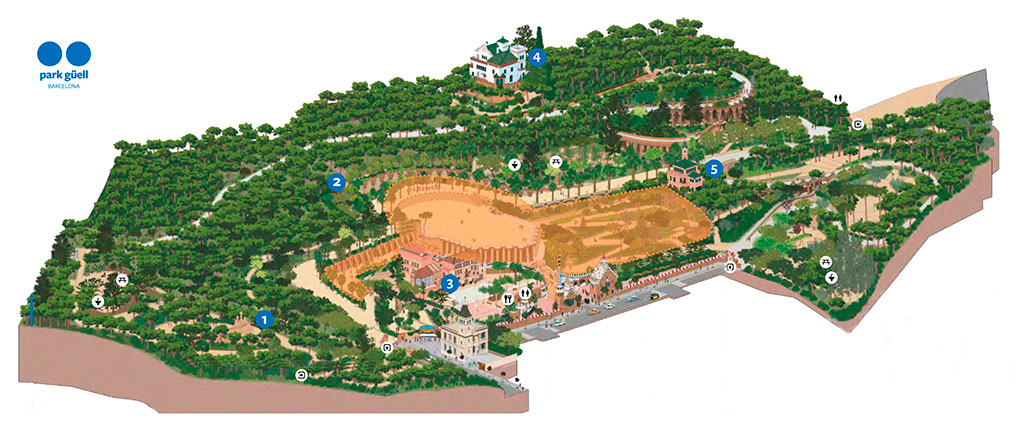The Park Guell is a 12 hectares wide garden complex with architectural elements situated on the hill of el Carmel in the Gràcia district of Barcelona, Spain. It was designed by the Catalan architect Antoni Gaudi and built in the years 1900 to 1914.
It is part of the UNESCO World Heritage Site Works of Antoni Gaudí. The park was originally part of a commercially unsuccessful housing site, the idea of Count Eusebi Guell, whom the park was named after. It was inspired by the English garden city movement, hence the original English name Park. Although it sounds unlikely, the place is skillfully designed to bring the peace and calm that one would expect from a park.
Barcelona Park Guell Admission Ticket
Park Guell receives a large influx of visitors daily. It is the most visited park in the world, in 2023, received 4.4 million visitors (83% of tickets were sold in advance). To ensure your entry, we recommend purchasing your ticket in advance:
Park Güell Admission Ticket: Skip the line and book tickets in advance.
Combined entry: another option is a guided tour to the Sagrada Familia and Park Guell with skip-the-line:
Skip-the-Line Sagrada Familia & Park Guell Tour.
Park Guell Opening Hours
Park Guell is open every day of the year. Once inside Park Guell you can stay as long as you want, however, if you leave it you cannot re-enter.
Low season (from January 1st to March 28 / from October 25 to December 31):
from 08.30 to 18.15 (last entry time at 17.30)
Mid season (from March 29 to May 3rd / from September 7 to October 24):
from 08.00 to 20.00 (last entry time at 19.30)
High season (from May 4 to September 6):
from 08.00 to 21.30 (last entry time at 21.00)
Entrance gates to Park Guell
Park Guell has three entrances:
- Larrard street: It is the main entrance to the park. It is located at the intersection of Larrard and Olot streets.
- Carmel road: This entrance, also called Plaça de la Natura, is located on the west side of the park, right next to the Bus Turistic parking lot.
- Av. del Santuari de Sant Josep de la Muntanya: It is located on the east side of the park and has several escalators, if you have decided to walk up the hill after arriving by subway.
How to get to Park Guell
It can be reached by Bus Turistic, by underground railway (although the stations are at a distance from the Park), or by city buses.
- Bus Turistic: Blue line, the stop is Park Guell. The stop is located on Av. Mare de Deu de Montserrat, it takes 10 minutes on foot, and we would recommend the entrance on Carretera del Carmel through Av. Pompeu Fabra.
- Metro: Green line (L3), the stop is Lesseps station. From the Lesseps stop, it is a 20-minute walk, and we would recommend the entrance on Av. Santuari de Sant Josep de la Muntanya, which has an escalator.
- Bus: H6 and D40 lines, the stop is Travessera de Dalt. From bus stop, it takes 10 minutes walking. We recommend the access both from Av. del Santuari de Sant Josep de la Muntaya, with automatic stairs system, or from Larrard street.
- Taxis: Park Guell has two taxi stops located on Rambla de Mercedes and Carretera del Carmel.
- Private car: Access by private vehicle is discouraged, given that the parking spaces in the area are reserved for residents and, as such, marked with green lines on the pavement. Visitors arriving by private car can use the BSM Travessera de Dalt - Park Guell car park (Travessera de Dalt, 49).
Tips for visiting the Park Guell
- Buy your ticket online to avoid the lines when entering, as these can be very long.
- It is better if you go on a weekday. Weekends are usually very crowded, so if you can, try to go during the week to be quieter. Mornings are the best time to visit Park Guell, as there are usually fewer people and the weather is pleasant.
- Wear a hat and comfortable shoes. The park is on a hill and you are going to walk a lot because it is very big.
- Park Guell has toilets throughout the park (you have them indicated on the map to download).
- Bring water and some food if you plan to visit all sections of the park as you may spend hours walking and exploring its trails. Take advantage of the numerous picnic areas throughout the park to grab a bite to eat (you have them indicated on the map to download).
Barcelona Park Guell Map to download
Things you must see in Park Guell
Park Guell is one of Barcelona's most popular attractions, attracting visitors from all over the world. The architecture, views and beauty of this UNESCO World Heritage park are unlike anything you can find anywhere else. This is the highlights that you can’t miss on your visit to the Park Guell of Barcelona. The top places in this characteristic garden designed by Antoni Gaudi, one of the most curious in the world.
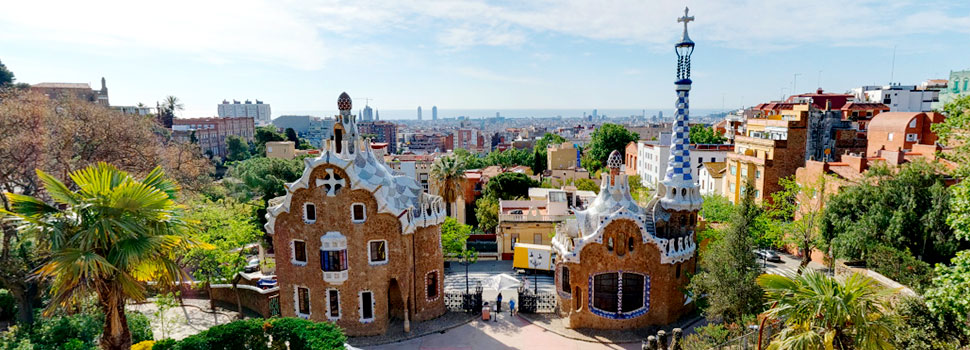
Park Guell Entrance
The buildings flanking the entrance, though very original and remarkable with fantastically shaped roofs with unusual pinnacles, fit in well with the use of the park as pleasure gardens and seem relatively inconspicuous in the landscape when one considers the flamboyance of other buildings designed by Gaudi.
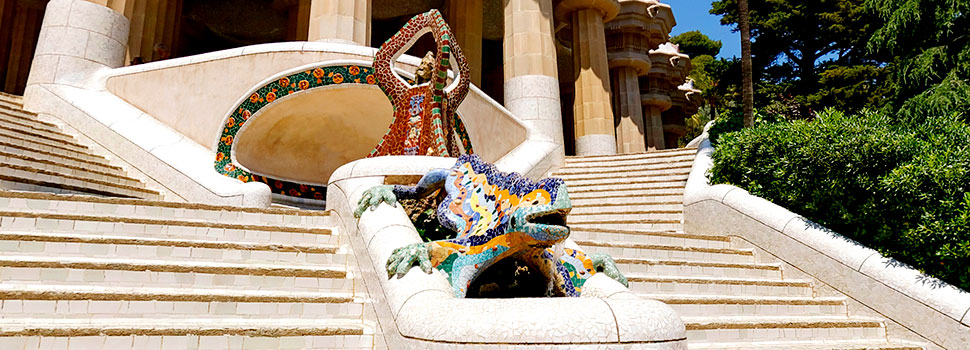
The monumental staircase
Here begins the monumental Dragon Staircase, presided over by the salamander finished in trencadís, which underlines the importance of access for pedestrians to the collective spaces of the garden city, the market and the square. The grand staircase leads to the Hypostyle Room, which was supposed to house the garden city market and is made up of 86 Doric style columns.
The monumental staircase is double and is organized into three sections where rocks and vegetation combine. The staircase is decorated with a pipe in the shape of a snake's head on the coat of arms of Catalonia, a very brightly colored dragon (which has become the most popular image in the park) and a tripod that appears to be formed by three snakes.
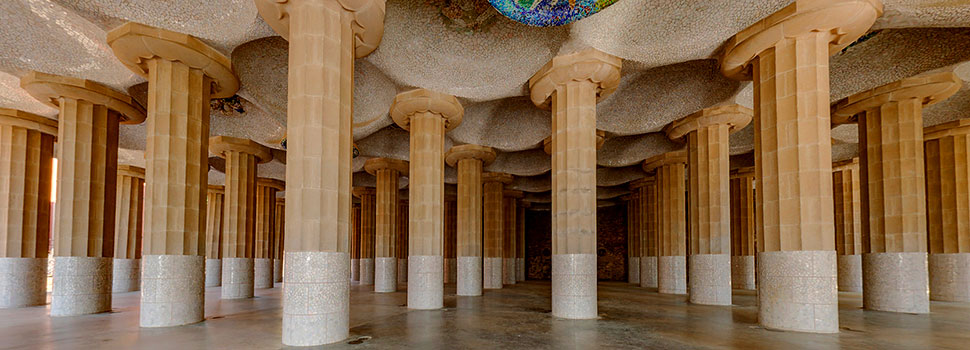
Hypostyle Room
It is a covered hall, initially designed as a market, with 86 fluted columns inspired by the Doric order that seem to create an undulating movement. The roof is made up of small domes covered in trencadís and with circular panels designed by the architect Josep Maria Jujol that represent the 4 seasons, as well as 14 smaller panels that represent the lunar cycle.
Portico of the washerwoman
Located to the east of the terrace, behind an iron gate is the access to what were the gardens of Casa Larrard, the house that was owned by Eusebi Guell and which is today a school. The porch is a true work of art, shaped like a large wave on inclined columns and a spiral ramp that allowed you to descend into the house. The porch, made of rough stone and shaped like a large wave, is formed by a set of columns, one of which is shaped like a caryatid, representing a washerwoman carrying her work utensils.
The main terrace of Park Guell
The focal point of the park is the main terrace, surrounded by a long bench in the form of a sea serpent. To design the curvature of the bench surface Gaudi used the shape of buttocks left by a naked workman sitting in wet clay. The curves of the serpent bench form a number of enclaves, creating a more social atmosphere. This square was intended to hold outdoor shows and popular Catalan culture events.
In the middle of the monumental area, is the plaza, which begins in the mountain, on solid ground, and extends above the columns of the Hypostila Hall. The trencadís bank that delimits its perimeter stands out and whose edge serves as a bank and undulates like a snake one hundred and fifty meters long. This bench is also covered with trencadís made of small pieces of ceramic and glass and is the work of Josep Maria Jujol, a collaborator of Gaudí. Next to the square we find an old stately farmhouse that has been a school since 1931.
Gardens of Austria
The Austrian garden is an old orchard where the species that would later be placed in the park had to be grown. However, for many years foreign species were planted, making it a non-Mediterranean garden. In recent years, more suitable plants have been introduced: olive trees, pines, oaks, broom, durillo, magnolias and aromatic plants.
These gardens owe their name to a donation from trees from Austria planted in 1977.
The three viaducts
The three viaducts (lower, middle and high bridges) make it possible to overcome the inclined topography of the land and facilitate communication between the various areas of the park. On the upper part, they are paths for vehicles and, on the lower part, they provide protection from the sun and rain.
The hill of the three Crosses (the Calvary)
The Calvary, a small mountain with 3 crosses, at the Park's high-point offers the most complete view of Barcelona and the bay. It is possible to view the main city in panorama, with the Sagrada Família and the Montjuic area visible at a distance.
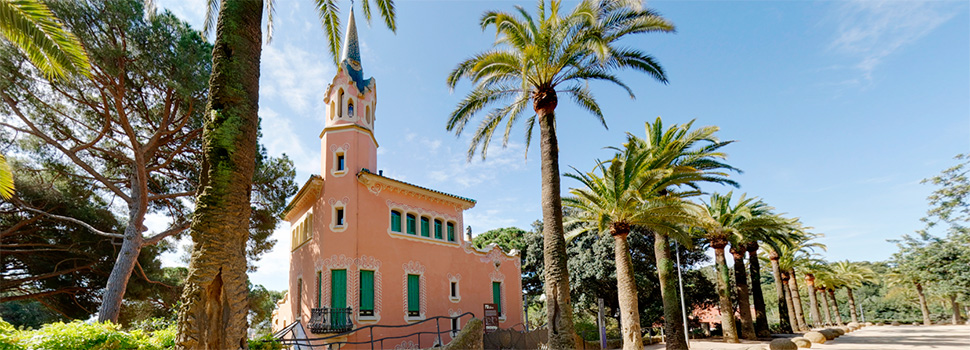
The Gaudi House-Museum
To learn more about the figure of the great Catalan artist, in the park you can also visit the house where Gaudí lived between 1906 and 1925, until just a few months before his tragic death, run over by a tram on June 10, 1926. The beautiful modernist mansion, designed by his collaborator Francesc Berenguer, allows you to delve into Gaudí's intimacy by touring his bedroom and study. In addition, the museum preserves several objects and original furniture designed by the architect.
Park Guell Online Map
History of Park Guell
Park Guell is one of the most beautiful places in Barcelona. It is a public park, located on Muntanya Pelada. At first, Antoni Gaudi, its architect, conceived it as an urbanization, but twelve years after the end of its construction, in 1926, it was inaugurated as a public park. It owes its name to the businessman who ordered it to be built, Eusebi Guell, and his work took fourteen years to complete. It has very characteristic gardens and architectural elements.
The site was a rocky hill with little vegetation and few trees, called Muntanya Pelada (Bare Mountain). It already included a large country house called Larrard House or Muntaner de Dalt House, and was next to a neighborhood of upper class houses called La Salud. The intention was to exploit the fresh air (well away from smoky factories) and beautiful views from the site, with sixty triangular lots being provided for luxury houses. Count Eusebi Güell added to the prestige of the development by moving in 1906 to live in Larrard House. In the event only two houses were built, neither designed by Gaudi. One was intended to be a show house, but on being completed in 1904 was put up for sale, and as no buyers came forward. Gaudi, at Güell's suggestion, bought it with his savings and moved in with his family and his father in 1906.
The project would be a commercial failure. The high price of the plots and the fact that they were far away and poorly connected to the center, among other reasons, meant that there were hardly any interested buyers. The works would be abandoned at the beginning of the First World War, in 1914. After the death of Eusebi Guell, in 1918, the City Council decided to buy the property, which would finally be opened as a public park in 1926.
Gaudi incorporated many motifs of Catalan nationalism, and elements from religious mysticism and ancient poetry, into the Park. The visitor was originally greeted by two life-size mechanical gazelles (a major euphemistic symbol of 'the young beloved' in the Hebrew strand of the medieval love poetry of the region), but these have since been lost during the turbulence of war.
Roadways around the park to service the intended houses were designed by Gaudi as structures jutting out from the steep hillside or running on viaducts, with separate footpaths in arcades formed under these structures. This minimized the intrusion of the roads, and Gaudi designed them using local stone in a way that integrates them closely into the landscape. His structures echo natural forms, with columns like tree trunks supporting branching vaulting under the roadway, and the curves of vaulting and alignment of sloping columns designed in a similar way to his Church of Colonia Guell so that the inverted catenary arch shapes form perfect compression structures.
Barcelona Pictures
We offer you all the tourist highlights of Barcelona city through the pictures of the main sights and attractions. Visit our Collection of photos about Barcelona. We invite you to enjoy this pictures.



